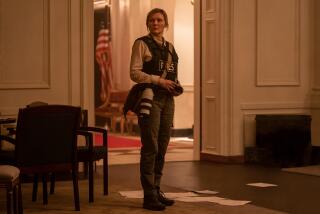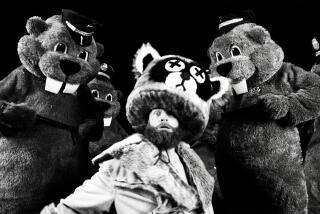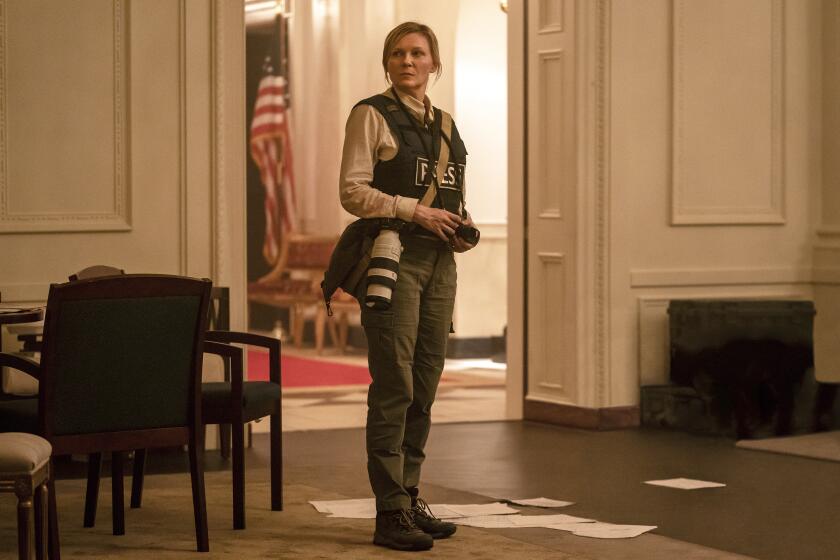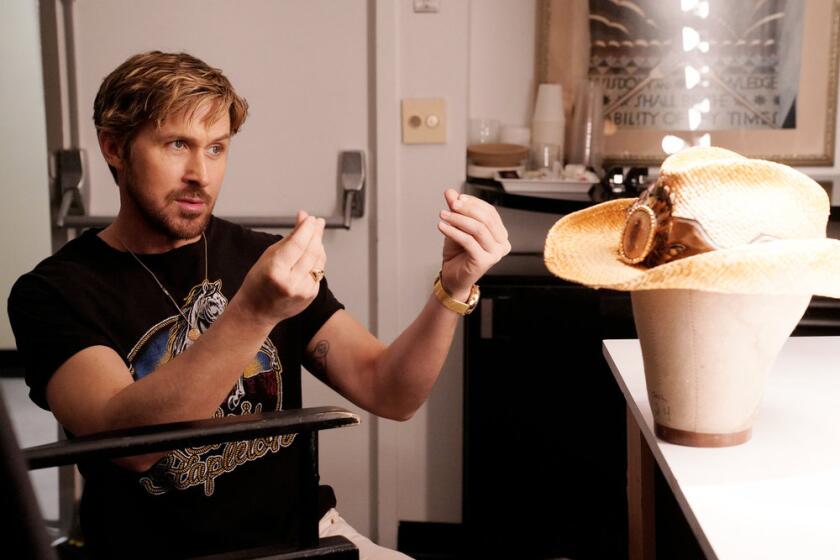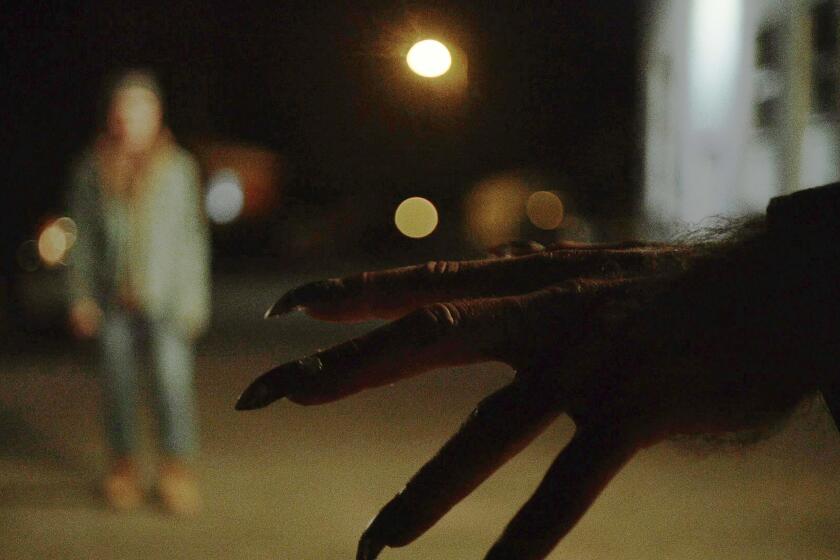There’s no place like hell for the holidays
As imagined by British novelist P.D. James in “The Children of Men,” the very near future isn’t a place you’d ever want to visit.
A worldwide infertility crisis threatens the human race, terrifying gangs prey upon the dwindling populace, and the desperate and elderly queue up for government-sponsored euthanasia. Yet as bleak as James’ vision might be, it can’t compare to the horrors dreamed up by filmmaker Alfonso Cuaron in adapting her novel for the screen.
Hollywood stands rightly convicted of whitewashing previously published material, but Cuaron and his “Children of Men” creative team are not ones to follow show business precedent. The director didn’t just want to make “Children of Men” more visceral, he also tried to make it additionally prophetic. And that’s when Cuaron and his collaborators found that the more suffering they invented, the more credible they believed their movie became.
“We didn’t want to do a science fiction movie,” says Cuaron, the director of “Y Tu Mama Tambien” and “Harry Potter and the Prisoner of Azkaban.” “We wanted to do a movie about the state of things.”
The state of things, as the movie has it, is one narrow step shy of the apocalypse. Almost all of the cataclysms imagined by James remain, but in the film they’re juiced on steroids: Infertility shares the stage with an all-out war against immigrants, and the environment is collapsing at an alarming rate. The crumbling social and political infrastructure from the novel has become in Cuaron’s movie a chaotic mix of anarchy and totalitarianism.
When it was published in 1992, James’ book was set 29 years ahead -- 2021. It took more than a decade to turn “The Children of Men” into a movie, but in the intervening 14 years, the gap between the present and the story’s imagined future contracted; the drama now unfolds just 21 years over the horizon.
“It’s more relevant than most movies that are set in the present,” says Clive Owen, who stars in the film as its reluctant protagonist, Theo. “It’s not farfetched. It’s a cautionary tale.”
Although “Children of Men” tries to end with a hopeful development, it’s not the kind of film typically associated with holiday cheer -- the film opens on Christmas Day.
“It’s a very expensive movie,” Cuaron says of his production’s $87-million budget (which will be reduced to about $75 million through British incentives). “And our co-lead is a black girl with an African accent.”
*
A Sisyphean task
When Hilary Shor read James’ book, the producer’s first child was not yet 2 months old. “There is something organic that happens to you when you’ve had a child,” says Shor. “When you have to protect this little baby.”
The little baby in “The Children of Men” wasn’t yet born. Like the movie, the novel opens with the death of the youngest person alive -- in the book he’s 25; in the movie he’s 19.
It’s symbolically crushing news, but soon thereafter, a woman becomes pregnant. It’s only one person, one baby, but it signals salvation for a collapsing world. Theo, who has grown apathetic as the world falls into ruin, becomes the guardian of the mother-to-be.
A former talent agent, Shor promptly optioned the James book in her first deal as a producer. “Then it was like Sisyphus pushing a rock up a mountain,” she says.
James insisted (and was granted contract language guaranteeing) that the movie be set in Britain. “Certain writers would come in and say, ‘Let’s do an ‘Independence Day’ version of the movie, something set in the United States,’ ” Shor says. “And I would say, ‘That isn’t going to fly.’ ”
But the story’s location wasn’t its primary impediment. “A lot of directors saw it as science fiction,” Shor says. “I saw it as something more humanistic. This is not about a bunch of guys flying around in saucers with silver lame suits.”
Eventually Shor partnered with “Spy Game” producer Marc Abraham, and Cuaron was approached. At the time, the Mexican writer-director had made “A Little Princess” and “Great Expectations,” but his “Y Tu Mama Tambien” had not yet opened.
That Spanish-language movie became an art house hit, but right on the heels of Sept. 11. Cuaron says the terrorist attacks didn’t necessarily stall “Children of Men,” but the project failed to generate sufficient momentum at Universal Pictures. “They were not ready to do it -- the studio, the producers,” Cuaron says. “They didn’t get the movie.”
Cuaron promised Shor he would return to “Children of Men” after he made his “Harry Potter” sequel. Unlike so many Hollywood promises, he was true to his word.
“You never know if people are going to come back,” Abraham says. “But he came back with fire in his belly.”
Cuaron’s “Harry Potter” had made the director even hotter (the film grossed $249.5 million), and his spending two years in London making the movie changed his view of the world.
“A film set is a microcosm of society. It’s almost like a caste system -- people know their place,” Cuaron says. “Class in Britain is pinpointed by accents. And I had an accent.”
With television writer Tim Sexton, Cuaron set out to rework the half-dozen or so “Children of Men” scripts. The aftermath of Sept. 11 gave the project new topicality. “The world of them and us came into such clarity,” Shor says.
Cuaron and Sexton also found that real-life current events -- the spirited debate over the U.S.-Mexico border, charges of American soldiers’ abuse of prisoners of war, more foreboding evidence of global warming -- informed the screenplay’s evolution.
“What we kept on doing with the script was to update,” Cuaron says. “We wanted the script to be referential.”
Those contemporary references, however, clashed with the film’s initial production design, which looked more Buck Rogers than urban decay. One of the initial design presentations included futuristic floating cars. “I said, ‘This is amazing. But this is not the movie we are going to do,’ ” Cuaron says.
Rather, the filmmaker wanted the future to look much like today, just worse -- technology, in Cuaron’s framing of the movie, stopped evolving in 2014. Besides saving a bundle on set and costume design, the choice meant the movie would seem more realistic, more possible.
“We didn’t want to be distracted by the future,” Cuaron says. “We didn’t want to transport the audience into another reality.”
That reality wasn’t filled with a lot of exposition and character study. The movie isn’t interested in explaining why everyone’s infertile or how a democracy turns into a military dictatorship. “I was very concerned about trying to explain too much,” Cuaron says. “That to me is a corruption of cinema storytelling.”
That meagerness made at least one of Cuaron’s actors nervous. And what is clear in Cuaron’s head may leave some moviegoers scratching theirs.
“When I first got the script, I wasn’t sure what I could do with the part -- he’s an elusive character,” Owen says of Theo. But when the “Closer” actor met with Cuaron and heard his vision of London in the future, Owen signed on. “He wanted the movie,” Owen says, “to discuss things that are freaking out people now -- immigration, environmentalism and terrorism.”
*
Use of long takes
Movie directors love to show off, and one of the ways they strut their stuff is with long, single-take shots -- they’re a hallmark of Brian De Palma.
Cuaron and longtime cinematographer Emmanuel Lubezki also were drawn to such lengthy shots but for a different reason: They felt they would immerse the audience in the story. Rather than offer close-ups of the actors’ faces, Cuaron and Lubezki focused their cameras on the performers running around their crumbling world.
“I think they are pretty staggering, but they are not showy,” says Owen, who was called on to perform scenes 10 minutes and longer, many of them filled with gunfire, explosions and crashes. “They are trying to put you viscerally in the middle of things -- to make you feel you are in the situation.”
To film such long takes required days of rehearsal, and on some days, not a foot of film was shot. “You can imagine the phone calls,” Owen says. But Abraham says he was more worried when they were filming: “The only time you get nervous is when it’s going and it’s for real,” he says. “You just want one in the can.”
James says that even with its many departures, she very much enjoyed the film -- amazingly, the first feature made out of any of her 17 novels.
“It’s not very much like the book, but that always happens,” she says. “I described much more the loss of hope. The movie is more of an adventure film. And there’s far more open violence in the movie, undoubtedly. It’s a brutal picture of a society in complete breakdown. The film does grow out of the book, there’s no doubt. The ideas are just treated in very different ways.”
James says that even though the book and novel “are not really credible,” she says both are grounded in indisputable truths -- the falling birthrate in some parts of the world, the marginalization of the elderly.
James says she isn’t sure how prophetic her book might be, and Cuaron certainly hopes his movie isn’t describing an imminent crisis. But the filmmaker still sees “Children of Men” as making a statement, reverberating long after the movie is finished.
“Enjoyment of the present -- I think that’s what modern capitalism is about: Our immediate needs, without consideration for the consequences of our actions,” Cuaron says.
“We wanted to make a movie that begins when the lights come on.”
*
More to Read
Only good movies
Get the Indie Focus newsletter, Mark Olsen's weekly guide to the world of cinema.
You may occasionally receive promotional content from the Los Angeles Times.
